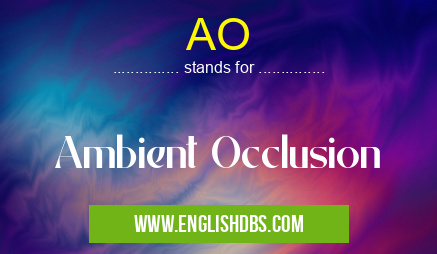What does AO mean in UNCLASSIFIED
Ambient Occlusion (AO) is a computer graphics technique used to add a degree of realism to 3D renderings. It produces shadows in areas where two surfaces or objects meet, creating a more realistic impression of lighting and shadows. Ambient Occlusion also helps reduce the ‘flat' look that is often associated with 3D images, by adding depth and texture.

AO meaning in Unclassified in Miscellaneous
AO mostly used in an acronym Unclassified in Category Miscellaneous that means Ambient Occlusion
Shorthand: AO,
Full Form: Ambient Occlusion
For more information of "Ambient Occlusion", see the section below.
What It Does
Ambient Occlusion essentially simulates the effect of light reflecting off surfaces onto its surroundings. By rendering an image based on this concept, it can add an extra layer of detail and realism that was previously unattainable. In addition to providing better lighting results when trying to create photorealistic images, it also offers better performance than more traditional types of shadow mapping.
How It Works
Ambient Occlusion works by casting rays from a point on the object being rendered out into the scene. These rays test for occluded surfaces and calculate how much light should be blocked from reaching the rendered object based on their distance from the surface being tested for occlusion. Once this information is collected, it can then be used to determine how much ambient light should be present in any given area of the scene - creating realistic shadows and lighting conditions from any angle or viewpoint.
Essential Questions and Answers on Ambient Occlusion in "MISCELLANEOUS»UNFILED"
What is Ambient Occlusion (AO)?
Ambient Occlusion is a shading method used in computer graphics to simulate how much ambient light from the environment will be occluded by nearby objects or surfaces. This technique allows for realistic calculation of shadows and ambient lighting, creating more natural-looking images than what can be achieved through traditional rendering techniques.
How does Ambient Occlusion work?
Ambient Occlusion works by adding shadows cast by other objects in the same scene. It calculates how much ambient light each object should receive depending on its relationship to the other objects within the scene, taking into account occlusions that the ray of light may experience while travelling through 3D space.
What are the benefits of using Ambient Occlusion?
The main benefit of using Ambient Occlusion is that it produces more accurate and realistic shadows and lighting effects, creating better depth and atmosphere in your scenes. It's also useful for emphasizing small details such as wrinkles or cracks, making them stand out more clearly. Additionally, it increases render speed significantly compared to other methods due to its efficiency.
What kind of applications use Ambient Occlusion?
Ambient Occlusion is widely used in many different industries and applications, from video games and films to architectural visualizations and industrial simulations. Its ability to create detailed shadows makes it ideal for a wide range of projects, ensuring maximum realism with minimal effort.
Does Ambient Occlusion require a lot of resources?
No, compared with other rendering techniques, Ambient Occlusion requires very little computational resources and memory usage. By avoiding heavy calculations on global illumination algorithms, AO significantly reduces render times while still producing high quality results.
Are there any downsides to using Ambient Occlusion?
While AO provides many benefits over traditional rendering techniques, there are some drawbacks which need to be taken into consideration when applying it in your projects. One common downside is that AO can produce artifacts where objects are intersecting each other or overlapping; this type of shading can cause unwanted shadow shapes or false intensity shifts in certain areas of an image.
Does every renderer support Ambient Occlusion?
Yes! Most modern 3D renderers support AO natively or through plugins/add-ons like V-Ray or Mental Ray in case you're not working with a real time engine such as Unity3D or Unreal Engine 4 which already have native support for this type of shading technique built-in.
Is it possible to adjust how strong my AO render looks like?
Yes! All major 3D renderers allow you to configure different parameters within their settings menus such as sample count (the number of points needed) and distance attenuation factors (how far away from the camera will certain points be sampled). Additionally you can also tweak contrast levels directly from within your image editor if necessary after render completion in order to fine tune your final look.
Final Words:
In conclusion, Ambient Occlusion (AO) is an effective way to simulate realistic light reflections in 3D renderings by casting rays and testing for occluded surfaces. It adds depth and texture to 3D images while providing better performance than traditional methods like shadow mapping - making it an invaluable tool for those looking to produce photorealistic images.
AO also stands for: |
|
| All stands for AO |
